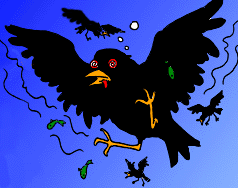


Article synopsis:
A toxin produced by certain phytoplankton can pose dangers when it passes up through the food chain. On rare occasions sea birds ingest enough of this toxin through the fish they eat to cause them to behave strangely. Hitchcock's movie "The Birds" was very loosely based on one of these rare incidents.
Article citation:
"Researchers May Have Solved Mystery of 'The Birds'," Associated Press, Jul. 11, 1995, p. .
Article summary:
The marine phytoplankton called Pseudo-nitzschia australis produces domoic acid, a substance which can cause neurological damage in birds and mammals if consumed in sufficient quantities. When ocean conditions lead to a plankton bloom -- a dramatic increase in the number of plankton -- the sea creatures that feed on plankton can become contaminated with domoic acid. This in turn presents a hazard to animals further up the food chain.
In 1991 many seabirds around Monterey Bay in California were found to have been poisoned by domoic acid through the anchovies that the birds fed on. The unusual behavior of some of the poisoned birds brought to mind a very similar incident in 1961 in which flocks of birds descended on shoreside communities, nipping passersby, running into cars, and generally behaving as if intoxicated. Alfred Hitchcock's movie "The Birds," which was based in part on a Daphne DuMaurier short story, was also inspired by this incident.
Domoic acid poisoning has also affected people directly. In 1987 a hundred people on Prince Edward Island in Canada suffered from dizziness, nausea, and memory loss after consuming contaminated mussels. Four people died from the effects of the toxin.
Please note! Use of this World-Wide Web site is being monitored for educational research purposes. Comments submitted by visitors such as yourself may be included in published research reports. Reports quoting such comments will not include the actual names of their authors. If you are not comfortable with this, you may wish to forgo E-mailing your comments to us.